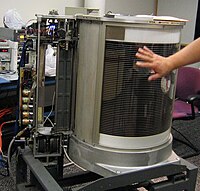
Photo from wikipedia
With the application of the composite cross-arm in power systems, comprehensive anti-aging performance is a key factor to determine whether it can operate safely. In order to study the influence… Click to show full abstract
With the application of the composite cross-arm in power systems, comprehensive anti-aging performance is a key factor to determine whether it can operate safely. In order to study the influence of the operating environment on the external insulation characteristics of composite cross-arms of distribution networks, various aging conditions such as voltage, rain, temperature, humidity, salt fog and ultraviolet light were simulated in a climate chamber based on the real operation conditions of the 10-kV composite cross-arm. A multi-factor aging test of composite cross-arms with two kinds of cross-section shapes (T-shaped and square) was carried out for 5000 h. The change trends of leakage current and flashover voltage of the composite cross-arms before and after aging were analyzed. Finally, the aging mechanism of the silicone rubber sheaths was analyzed to further explain the reasons for the change of external insulation performance of composite cross-arms. The results show that the leakage current rising rate of T-shaped and square composite cross-arms after aging increases significantly, and the minimum flashover voltage decreases to 58.3 kV and 49.502 kV, respectively. The results of FTIR, SEM and hydrophobic angle tests show that, after aging, the performance of the silicone rubber outer sheath material decreases in varying degrees. In general, UV aging has the greatest influence on the external insulation characteristics of composite cross arms. Generally speaking, after 5000 h of multi factor aging, although the external insulation characteristics of the 10-kV composite cross-arm decreases to a certain extent, there is still enough margin to meet the normal operation.
Journal Title: Polymers
Year Published: 2022
Link to full text (if available)
Share on Social Media: Sign Up to like & get
recommendations!